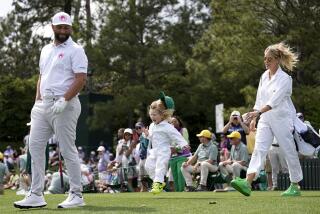Southlanders Now Know Grass Greener for Them
- Share via
WIMBLEDON, England — Their games were created on the concrete courts of Southern California. Pete Sampras and Lindsay Davenport learned to play tennis on the smooth, predictable hard courts, indoors and out, where the bounces were always true, where there were never any bumps or mole hills or slippery spots.
For each of them, then, their inaugurations to Wimbledon were unpleasant. Losses to nobodies and muttered complaints about that silly grass, about that disconcerting rain, about how they could never be expected to win tournaments at such an un-California place.
Yet there each stood on Sunday, Sampras and Davenport, holding Wimbledon championship hardware, trying to hide tears and trying to express, with little shrieks and wide smiles, their exhilaration.
Davenport now lives in Newport Beach, and Sampras now has homes in both Beverly Hills and Orlando, Fla. But at different times both lived in Rancho Palos Verdes and trained at the Jack Kramer facility there and also the West End Club in Torrance.
Both have been raised in very untennislike families. Mothers and fathers who haven’t hovered. Serious attachments to their coaches. No entourages, no controversies, no tabloid headlines about either.
And Sunday night, when Sampras and Davenport danced together as Wimbledon champions, maybe they laughed a little about how silly they were to be so afraid of a little green grass.
Sampras, who will turn 28 in six weeks, won his sixth Wimbledon title Sunday and tied Roy Emerson for the all-time lead of 12 Grand Slam titles.
When he first arrived at Wimbledon, a gangly teenager with elastic arms and a sprinter’s first step toward the net, Sampras made an impression on beloved British tennis icon Fred Perry.
Perry watched Sampras, with his fluid one-handed backhand and his fearless approach to serving and volleying and declared that, absolutely, Sampras would some day, probably soon, be a Wimbledon champion.
That was in 1989 and Sampras went out and lost in the first round to Todd Woodbridge. Then Sampras said he really didn’t like playing tennis on grass. A year later, a little older, no wiser, Sampras lost in the first round to Christo van Rensburg and more emphatically than the previous year spoke about his dislike of this awful green surface. But Sampras returned. In 1991 Sampras made it all the way to the second round, where he lost to Derrick Rostagno, proclaimed himself disgusted with grass, his performance on grass, the whole idea of grass.
Since then, Sampras has won six of the eight Wimbledons contested including Sunday, when Sampras put on a breathtaking display of grass-court tennis, of skillful angles and clever shotmaking from all corners and beat his worthy opponent, Andre Agassi, 6-3, 6-4, 7-5.
Sampras, with his six Wimbledon titles, is now considered perhaps the all-time best on grass. And from watching Sampras, Lindsay Davenport has learned.
“If you look at Pete’s record,” Davenport said after a 6-4, 7-5 victory over Graf, “I think out of his last 44 matches [47 actually], he’s lost once. But then, if you look at the beginnings, he lost a few times on grass and you realize it’s a tough surface to get used to. You can’t describe it unless you play on hard courts and then you play on grass.”
To win on grass is a matter of will as well as ability.
While Fred Perry knew that Sampras had talent from watching the young Californian move, serve and use his singular backhand, it was the head that needed nurturing.
Sampras has said it was the continual prodding of his late coach, Tim Gullikson, that finally convinced him it was possible to move beyond those California hard courts and become a more complete champion.
It was the same for Davenport. She had been no better than a quarterfinalist here before--twice she was a second-round loser, once a third-round loser--in six previous trips, and a 15-1 underdog this year. “I just didn’t believe I could do well on grass,” Davenport said. “Two or three years ago, I didn’t feel I belonged here.”
Robert Van’t Hof, a former ATP pro and Davenport’s longtime coach, said the belief you can win on grass “is everything.” It was a belief Davenport was slow to acquire. “I don’t know why,” she said, “but I felt my game was only suited to hard courts.”
After Davenport won her first Grand Slam title, at the U.S. Open last September, she remembered something John McEnroe had said about Patrick Rafter in 1997 after Rafter won his first Grand Slam title at the U.S. Open.
“He called Rafter the one-slam wonder and now, to win two for myself, obviously nobody can ever take that away,” Davenport said. “To win on two different surfaces means I’m a pretty good all-round player.”
From where he was in 1989, an overmatched youngster who scrunched up his nose in disgust at the grass, Sampras now says, “Once I step on that Centre Court, there is something this court has in atmosphere and this place brings out the best of me.”
And before Sampras left the grounds with his record-tying title, Sampras had one last word. “I’m happy for Lindsay,” Sampras said. “She’s from Palos Verdes and so am I and that’s pretty cool.”
We second that emotion. That’s pretty cool.
*
Diane Pucin can be reached at her e-mail address: diane.pucin@latimes.com
More to Read
Go beyond the scoreboard
Get the latest on L.A.'s teams in the daily Sports Report newsletter.
You may occasionally receive promotional content from the Los Angeles Times.










